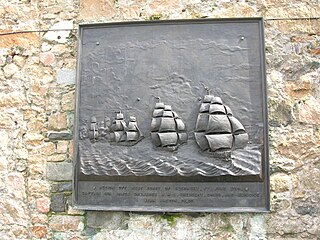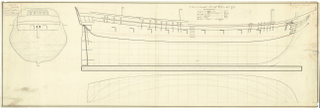
HMS Galatea was a fifth-rate 32-gun sailing frigate of the British Royal Navy that George Parsons built at Bursledon and launched in 1794. Before she was broken up in 1809 she captured numerous prizes and participated in a number of actions, first in the Channel and off Ireland (1794–1803), and then in the Caribbean (1802–1809), including one that earned her crew the Naval General Service Medal.

Franchise was launched in 1798 as a 40-gun Coquille-class frigate of the French Navy. The British captured her in 1803 and took her into the Royal Navy under her existing name. In the war on commerce during the Napoleonic Wars she was more protector than prize-taker, capturing many small privateers but few commercial prizes. She was also at the battle of Copenhagen. She was broken up in 1815.
Vénus was a corvette of the French Navy that the British captured in 1800. Renamed HMS Scout, she served briefly in the Channel before being wrecked in 1801, a few days after taking a major prize.

Pomone was a 40-gun frigate of the French Navy, launched in 1785. The British captured her off the Île de Batz in April 1794 and incorporated her into the Royal Navy. Pomone subsequently had a relatively brief but active career in the British Navy off the Atlantic and Mediterranean coasts of France before suffering sufficient damage from hitting a rock. Due to this, the ship was taken out of service and then broken up in 1803.
Sardine was a corvette of the French Navy, launched in 1771. The Royal Navy captured her at the Siege of Toulon but the French retook her when the Anglo-Spanish force retreated. The Royal Navy captured her again in 1796. She then served as HMS Sardine until the Royal Navy sold her in 1806.
His Majesty's Hired armed lugger Duke of York served the Royal Navy from 14 October 1794 to 2 January 1799 when she foundered in the North Sea.
HMS Nemesis was a 28-gun Enterprise-class sixth-rate frigate of the Royal Navy. The French captured her in 1795 at Smyrna, but in 1796 a squadron led by Barfleur brought her out of the neutral port of Tunis. Throughout her career she served under a number of commanders who would go on to have distinguished careers. She was converted to a troopship in 1812 and was sold in 1814.

Gracieuse was a 32-gun Charmante-class frigate of the French Navy. Renamed to Unité in 1793, she took part in the French Revolutionary Wars. The Royal Navy captured her in 1796 off Île d'Yeu and brought her into British service as HMS Unite. She was sold in 1802

HMS Arab was the French 20-gun corvette Jean Bart, launched in 1793. The British captured her in 1795 and the Royal Navy took her into service. She was wrecked in 1796.
HMS Cerbere was the French naval brig Cerbère, ex-Chalier, which the British captured in 1800. She was wrecked in 1804.
HMS Coureuse was a schooner launched in about 1785 at New York, that the French Navy acquired at Cayenne and armed and commissioned at Lorient in 1794. The British captured her in 1795 and the Royal Navy briefly used her as a dispatch vessel in the Mediterranean. The Admiralty sold her in 1799.

Etna was a French naval Etna-class ship-sloop launched in 1795 that the Royal Navy captured in November 1796. She was taken into service as HMS Aetna and renamed to HMS Cormorant the next year. She captured several merchant vessels and privateers before she was wrecked in 1800 off the coast of Egypt.
Poulette was a French Coquette-class corvette built to a design by Joseph-Marie-Blaise Coulomb and launched in March 1781. She served the French navy until 1793 when the British captured her at Toulon in 1793. She served briefly in the Royal Navy, including at the battle of Genoa in 1795, until she was burned in October 1796 to prevent her falling into French hands.

His Majesty's hired armed lugger Valiant served the Royal Navy on a contract from 5 May 1794 to 10 November 1801. She was of 109 90⁄94 tons (bm), and was armed with eleven 3-pounder guns.
Goéland was the name ship of a two-vessel class of "brick-avisos", built to a design by Raymond-Antoine Haran and launched in 1787. She served the French Navy for several years carrying dispatches until in 1793 HMS Penelope and HMS Proserpine captured her off Jérémie. The Royal Navy took her into service briefly as Goelan and sold her in 1794. As the merchant brig Brothers she appears to have sailed as a whaling ship in the British southern whale fishery until 1808 or so, and then traded between London and the Brazils. She is no longer listed after 1815.

The French gun-vessel Eclair was one of 20 chasse-marées built in 1785 in southern Brittany for use as service craft in harbour construction at Cherbourg. In 1793 Martin or Jacques Fabien converted ten of them into chaloupes-canonnières (gun-vessels). One of these received the name Eclair. Sir Richard Strachan's squadron captured her in 1795 in Cartaret Bay, and the Royal Navy took her into service as HMS Eclair. She then sailed to the West Indies where she was probably out of service by 1801. In 1802 she was hulked under the name HMS Safety. She then served as a prison ship at Jamaica around 1808 to 1810. She may have been sold at Tortola in 1817/18, but in 1841 or so was brought back into service there as a receiving hulk. She was broken up in 1879.

Crachefeu was a French Navy gun brig launched in 1793. Sir Richard Strachan's squadron captured her in 1795 in Cartaret Bay, and the Royal Navy took her into service as HMS Crachefeu. She then sailed to the West Indies where she broken up in 1797, or possibly around 1802.
The French brig Amarante, was launched in 1793 at Honfleur for the French Navy. The British Royal Navy captured her at the end of 1796 and took her into service as HMS Amaranthe. She captured one French vessel in a single-ship action before she was wrecked near Cape Canaveral, Florida, in 1799.

HMS Barbuda was commissioned into the Royal Navy in 1780 after having briefly served as an American privateer. Barbuda was one of the two sloops that captured Demerara and Essequibo in 1781, but the French Navy captured her there in 1782 and took her into service as Barboude. The French Navy sold her to private owners in 1786, and she served briefly as a privateer in early 1793 before the French Navy purchased her again and named her Légère. She served them until mid-1796 when the Royal Navy captured her and took her into service as HMS Legere. She was wrecked off the coast of Colombia, without loss of life, in February 1801.

HMS Vesuve was the French brick-cannonièreVésuve, name vessel of her class of seven bricks-cannonière. She was launched at Saint-Malo in 1793. The British Royal Navy captured her in 1795 and took her into service as HMS Vesuve. The Navy sold her in 1802.











